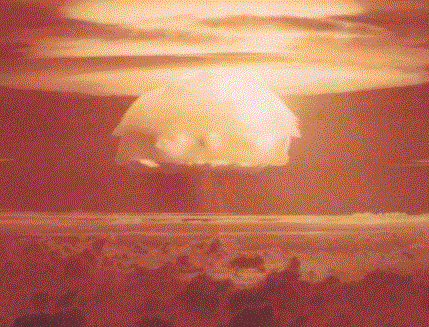Indian New Deal, Tribal Termination, and Urban Relocation 1934-1967
1954
Castle Bravo, 15-megaton hydrogen bomb blast, is detonated over Bikini Atoll

The bomb is the largest U.S. test ever, 1,300 times more destructive than the bombs dropped on Hiroshima and Nagasaki. People from the island of Rongelap are in the fallout zone and suffer cancer and major birth defects, including “jellyfish babies" (babies born without bones and with transparent skin). Six days after the Castle Bravo test, the U.S. government sets up a secret project to study the effects of the atomic bomb on the residents of the Marshall Islands. The U.S. is accused later of using the Marshall Islands residents as medical research subjects without their informed consent. The government assures islanders that they can return to Rongelap and live safely. Many return, only to flee again in 1985 when the U.S. finally announces that radiation levels on the islands are actually unsafe. By that time, communities are plagued with the effects of radiation damage, including significantly higher rates of miscarriages, birth defects, and cancer (Simon, 2010). On March 5, 2001, the Nuclear Claims Tribunal rules against the U.S. for damages done to the islands and its people. The U.S. pays islanders and their descendants $125 million in compensation for damage caused by the nuclear testing program and displacement from their home island. Between 1954 and 1958, one in three births on the Marshall Islands results in fetal death. Rates of hepatitis B and liver cancer are approximately 30 times higher in the Marshall Islands than in the U.S. Cervical cancer rates in women of the Marshall Islands are 60 times greater and rates of breast, lung, oral, and gastrointestinal cancer are 3-10 times greater than in the U.S. Life expectancy on the islands sharply decline, to 40 years. (http://archives.pireport.org/archive/2005/June/06-14-com2.htm)